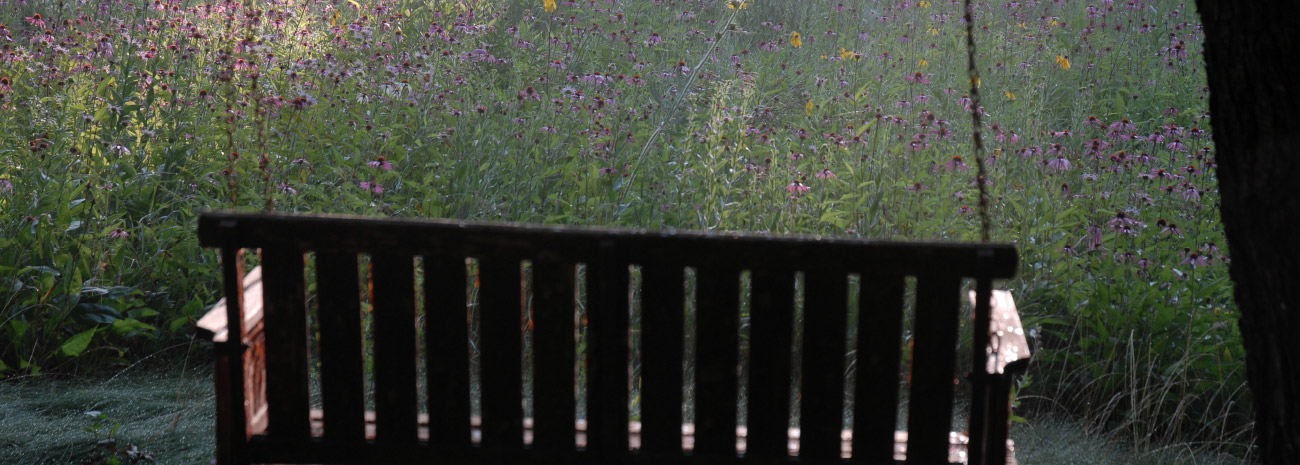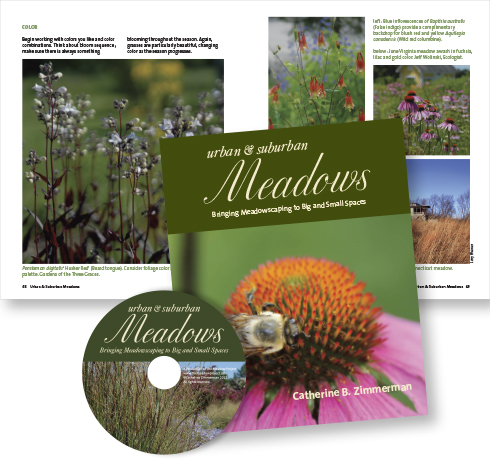“This skillfully crafted guide is a wonderful resource providing the gardener with concise step by step instructions on how to meadowscape existing lawns into easily managed, pesticide free, native meadow gardens that provide all-season beauty while protecting and providing for nature.”
—Steve Castorani, North Creek Nurseries
“This is a great book – beautiful and useful. It is totally organic in approach and gives step-by-step instructions (with pictures) for several different organic approaches to meadow establishment. It stresses the use of native plants and lays out the environmental benefits of meadows – providing habitat and food for wildlife, controlling erosion and restoring a natural water cycle, as well as the cost benefit of much reduced maintenance after establishment. The list of regional resources for creating meadows is a gold mine of information for meadow enthusiasts across the U.S. And, it has gorgeous pictures of meadows on practically every page.”
—Sarah Little, Ph.D. NOFA Organic Land Care Committee, Chair
“Before manicured lawns, with their chemicals, mowers, and blowers, there were ecological meadows, with their butterflies, birds, and bees. Catherine Zimmerman’s Urban and Suburban Meadows reintroduces readers to the beauty and biodiversity of the meadow and reminds them of the intricate connections between wildlife and native plant communities that serve as both food source and habitat. Whether restoring a small urban pocket garden or reclaiming an acre of suburban lawn, this beautifully photographed book will compel readers to plant these living landscapes. Zimmerman provides both the inspiration and the thoughtfully developed and comprehensive practical steps necessary for success.”
—Penny Lewis, Executive Director, Ecological Landscaping Association
“Urban and Suburban Meadows by Catherine Zimmerman (Matrix Media Press, 2010) is a practical compilation of information collected from Zimmerman’s background growing up on a small farm in the 1950s and ‘60s and her training and certification in horticulture and organic gardening. She captures the enjoyment of having a meadow garden and takes you through the steps of how to create one for yourself.
Zimmerman writes about meadows vs. monocultures and how to prepare the sites, and she provides 70 pages of contacts across the country. This how-to guide offers the most up to date information for succeeding at meadow gardening in urban and suburban settings.”
—Joel M. Lerner, Washington Post, Green Scene: Books to help plant gardening ideas
“THE CONCEPT of a meadow garden is simple: wildflowers, grasses, butterflies, and minimal maintenance. In reality, meadows are complex ecosystems that require some know-how to create. Enter horticulturist and landscape designer Catherine Zimmerman and her new book Urban and Suburban Meadows. Chock full of concise information, this book enables readers to envision meadows and prairies as achievable, low-maintenance gardens that offer a viable alternative to lawns. Imbued with Zimmerman’s passionate commitment to sustainable gardening, this well-researched book starts off by building a convincing case for meadow ecosystems versus monocultural lawns, complete with charts comparing costs. (On average, meadows are twice as expensive to install but half as expensive to maintain over time.) Integrating advice from a handful of experts, Zimmerman leads readers step by step from conception to fruition. Chapters cover topics such as site preparation, design, establishment, and maintenance, enhanced by plenty of color photographs, illustrations, and sidebars. A plant key presents recommended regional wildflowers and grasses grouped by soil moisture requirements.
The chapter on maintenance, with its dramatic photographs of raging conflagrations, may put a few readers off. While burning is the best way to maintain grasslands, it isn’t always tenable due to community ordinances, spatial concerns, and the expertise required to conduct a burn. That said, the book presents alternatives such as annual mowing, which are more practical for the home gardener.
It is difficult for any book to cover an entire continent, though this volume makes an attempt. The book’s overall focus is clearly east of the Rockies, yet a large number of pages are devoted to other regions, including brief descriptions of 84 eco-regions with diverse floras that are excluded or glossed over by the plant key. And because, as Zimmerman puts it, “finding local resources, such as nurseries, providing plants native to your area is a key element in the successful outcome of your meadow or prairie planting,” there is a section listing these re- sources for various regions around the country.
Despite the book’s ambitious scope, any reader considering a meadow, as a landscaping alternative will find it contains a wealth of information and clearly articulated step-by-step methodology for meadow making.”
—C. Colston Burrell, The American Gardener: The American Horticultural Society magazine





